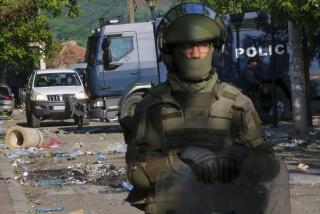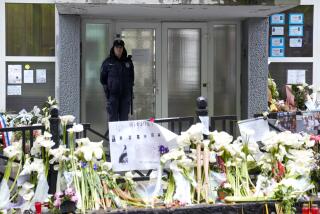Police Restore Calm in Yugoslav Region
- Share via
PRISTINA, Yugoslavia — A heavy show of force by Yugoslav federal police brought calm to the Kosovo region Wednesday after two days of violent disturbances that left 23 dead and scores injured.
In Pristina, the regional capital where ethnic Albanians began a series of protests eight days ago, heavily armed police clustered at street corners and checked identity papers of passers-by, but there were no other outward signs of the worst ethnic strife here since 1981, when nine persons were killed in similar disturbances.
High schools and the city’s university remained closed and a curfew remained in force between 8 p.m. and 5 a.m. Military units were bivouacked along the approaches to major towns, and a convoy of six heavy tanks was encountered rambling along the road between Pristina and Pec, where police had used tear gas to break up a crowd of demonstrators Tuesday.
A government information officer in Pristina, Marija Gasi, told journalists that 19 of the 23 deaths in the rioting occurred Tuesday, as police and ethnic Albanians clashed in eight Kosovo towns. Two of those wounded Tuesday died on Wednesday, but the spokeswoman said there were no new disturbances.
“The special security measures are beginning to take effect,” she said. “The situation is calming down. I think it will continue to be calm.”
The Albanians, who make up 95% of Kosovo’s 2 million population, have been protesting over constitutional changes by Serbia and the Kosovo provincial assembly that will allow the Serbs greater control over Kosovo.
The issue of Kosovo, an autonomous province in Yugoslavia’s federal system of republics and regions, has been gathering emotional heat for the last year, fueled by the Serbian Communist Party leader Slobodan Milosevic, who has appealed to Serbian feelings over Kosovo to rise to national prominence.
Seat of Culture
An economically backward region bordering on the nation of Albania, Kosovo is regarded by most Serbs as the seat of their ancient culture, and they complain that they have been steadily driven out of the area by the rapidly growing Albanian population. Serbs also claim that the Albanians are mismanaging the economy of the region.
The Albanians, who have little political muscle to flex in response, have nevertheless responded angrily to Serbian moves against them and began their protests after the constitutional changes were rammed through the Kosovo assembly with the help of Serbian allies in Kosovo.
The worst violence Tuesday--in the towns of Orahovac, Lipljan and Podujevo--coincided with the official ratification of the constitutional changes by the Serbian national assembly in Belgrade. The changes give Serbs greater control over the courts and the police in Kosovo.
Yugoslav journalists here said police were ordered to direct gunfire from automatic weapons over the heads of protesters and then into the ground in front of them if the first volleys failed to disperse the crowds. But some of the shots were clearly fired into the crowds.
Two federal police officers were killed Monday, apparently by snipers.
Officers say they have been regularly fired on from the crowds.
It is well known that many Albanians keep caches of firearms, and the police claims of being fired upon in crowds are generally accepted here, even by Albanians, whose rugged, mountain-people code of self-defense is a matter of personal honor.
Federal authorities have been weighing the imposition of a state of emergency in Kosovo. They may hold off on a decision if the calm that settled over the region Wednesday prevails in the coming days.
Most observers here, however, doubt that the longstanding economic ills of the region and the even longer enmity between the Serbs and Albanians have moved any closer to a lasting solution.
More to Read
Sign up for Essential California
The most important California stories and recommendations in your inbox every morning.
You may occasionally receive promotional content from the Los Angeles Times.













